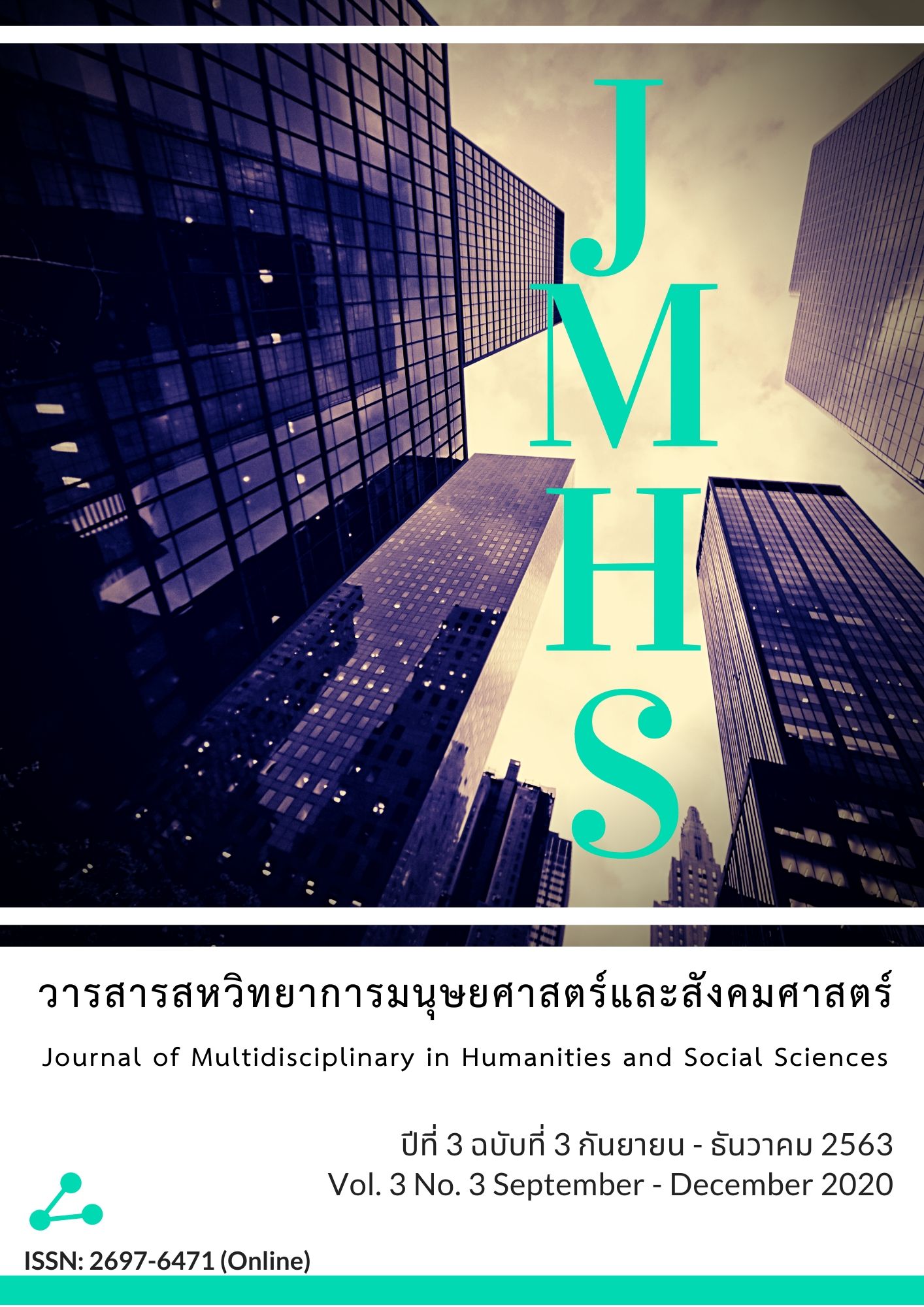The Development of a Training Program to Enhance Product Presentation Efficiency of a Unit-Linked Life Insurance Policy for Financial Advisors
Main Article Content
Abstract
The objectives of this research were (1) to study the components necessary to increase the efficiency of the offering of investment life insurance products for financial advisors; (2) to create a training program to increase the efficiency of the presentation of investment life insurance products for financial consultants; and (3) to assess training programs to increase the efficiency of offering life-insurance investment products for financial advisors the sample group in inquiring about opinions regarding necessary elements are life insurance brokers with investment. A sample was selected from 600 cases were included as a sample. The samples in this study were training program consisting of experts, academics, financial advisors, totaling 9 people, by using group discussion and the samples for evaluating the training program were 30 financial advisors from various companies using the tools Evaluation and trial of the training program. It was found that;
- The elements necessary to enhance the efficiency of the offering of investment life insurance products for financial advisors are as follows: There were 5 components which are 1) knowledge of investment life insurance products; 2) professional presentation skills; 3) ethics and guidelines propose correctly according to the guidelines; 4) collaboration skills for success; and 5) personality and attitude of being a financial advisor.
- Create a training program to increase the efficiency of offering life insurance products with investment for financial advisors. It was found that the training program outline is divided into 5 training units, which were learning unit 1: life insurance product knowledge and investment, learning unit 2: ethics and the proposed guidelines correctly according to the guidelines, learning unit 3: professional presentation skills learning, unit 4: collaboration skills for successful learning unit, and 5: personality and attitude of financial advisor.
- The evaluation of training programs to increase the efficiency of offering life-insurance products for financial advisors. It was found that the average score of knowledge of increasing the efficiency of offering life-insurance products was 4.20 from 5 points, higher than the specified criteria (not lower than 3.50).
The findings were as follows: (1) received training programs to increase the efficiency of offering life insurance products with investment for financial advisors; (2) guidelines for the development of training programs to increase the efficiency of other financial product presentations; and (3) obtain guidelines for developing an organization to have a competitive edge in the financial consulting business which will lead to a highly efficient organization.
Article Details
Views and opinions appearing in the Journal it is the responsibility of the author of the article, and does not constitute the view and responsibility of the editorial team.
References
คชบท พัชรโศภิษฐ์ และสุธรรม พงศ์สำราญ. (2561). ปัจจัยในการปฏิบัติงานของตัวแทนประกันชีวิตมีผลต่อประสิทธิผลในการปฏิบัติงานของตัวแทนประกันชีวิต บริษัท เอ ไอ เอ จำกัด. วารสารวิจัยและพัฒนามหาวิทยาลัยราชภัฏเลย, 13(44), 35-45.
จิณณวัตร เตชะพันธ์. (2557). แนวทางพัฒนาการเป็นตัวแทนประกันชีวิตให้ประสบความสำเร็จ กรณีศึกษา: ตัวแทนประกันชีวิตบริษัทไทยพาณิชย์ประกันชีวิต จำกัด (มหาชน) อำเภอหาดใหญ่ จังหวัดสงขลา. ปริญญาศิลปศาสตรมหาบัณฑิต. มหาวิทยาลัยราชภัฏสงขลา.
จิตติมา อัครธิติพงศ์. (2556). เอกสารประกอบการสอนวิชาการพัฒนาประสิทธิภาพในการทำงาน (Efficiency Development). พระนครศรีอยุธยา: คณะวิทยาการจัดการ, มหาวิทยาลัยราชภัฏพระนครศรีอยุธยา.
ณรงค์วิทย์ แสนทอง. (2547). มารู้จัก Competency กันเถอะ. กรุงเทพฯ: สำนักพิมพ์เอชอาร์เซ็นเตอร์.
ณัฎฐ์ภูอิสร์ ศรีเพชร. (2557). แนวทางการสร้างความไว้วางใจของลูกค้า ในธุรกิจประกันชีวิตในประเทศไทย. วารสารวิชาการมหาวิทยาลัยกรุงเทพธนบุรี, 3(2), 86-96.
ธำรง บัวศรี. (2542). ทฤษฎีหลักสูตร: การออกแบบและพัฒนา (พิมพ์ครั้งที่ 4). กรุงเทพฯ: โรงพิมพ์คุรุสภาลาดพร้าว.
ปิยะดา วีระวัฒนาพงษ์. (2562). รูปแบบการพัฒนากลยุทธ์การตลาดบริการเพื่อการรับรู้คุณค่าของตัวแทนประกันชีวิตในภาคเหนือตอนล่างของประเทศไทย. ปริญญาปรัชญาดุษฎีบัณฑิต, มหาวิทยาลัยสยาม.
พิสณุ ฟองศรี. (2549). การประเมินทางการศึกษา: แนวคิดสู่การปฏิบัติ (พิมพ์ครั้งที่ 4). กรุงเทพฯ: พร็อพเพอตี้พริ้น.
วารุณี สุวรรณาพิสิทธิ์. (2543). การสื่อสารระหว่างบุคคลในการสนับสนุนให้เกิดการทำประกันชีวิต. ปริญญานิเทศศาสตรมหาบัณฑิต. จุฬาลงกรณ์มหาวิทยาลัย.
สุวัฒน์ วัฒนวงศ์. (2544). จิตวิทยาเพื่อการฝึกกอบรมผู้ใหญ่. กรุงเทพมหานคร: ธีระป้อมวรรณกรรม.
Armstrong, D. G. (1989). Developing and documenting the curriculum. Boston: Allyn and Bacon.
Baek, H. Y., Kim, D., & Oh, J. (2019). Financial attitude, knowledge, investment behaviour and satisfaction among the clients of comprehensive financial planning services. Financial Planning Research Journal, 5(1), 11-28.
Billington, D. D. (1996). Seven characteristics of highly effective adult learning programs. Retrieved September 20, 2007, from http://www.newhorizons.org/lifelong/workplace/ billington.htm
Certo, C. S. (2000). Modern management. New Jersey: Prentice Hall.
Gilley, J. W., Eggland, S. A., & Maycunich, A. (2002). Principles of human resource development (2nd ed.). Reading, MA: Perseus.
Gordon, S. E. (1993). We do: Therefore, we leam. Training & Development, 47(10), 47-52.
Knowles, M. S. (1980). The modern practice of adult education: From pedagogy-’ to andragogy (Rev. and Updated). Chicago: Follett.
Knowles, M. S., Holton, E. F., III., & Swanson, A. R. (2011). The adult learner: The definitive classic in adult education and human resource development (7th ed.). Amsterdam, the Netherland: Elsevier.
Merriam, S. & Caffarella, R. (1999). Learning in adulthood: A comprehensive guide (2nd ed). San Francisco: Jossey Bass.
Roger, C. (1951). Client-centered therapy. Boston: Houston-Miffier.
Saylor, J. G., Alexander, W. M., & Lewis, A. J. (1981). Curriculum planning for better teaching and learning. New York: Holt, Rinehart & Winston.
Subramaniam, A., Ramalu, I., Wei, C. C., & Rose, R. C. (2011). The effects of cultural intelligence on cross-cultural adjustment and job performance amongst expatriates in Malaysia. International Journal of Business and Social Science, 2(9), 59-71.
Taba, H. (1962). Curriculum development: Theory and practice. New York: Harcourt, Brace & World.
Tyler, R. (1989). Basic principles of curriculum and instruction. Chicago: University of Chicago Press.


